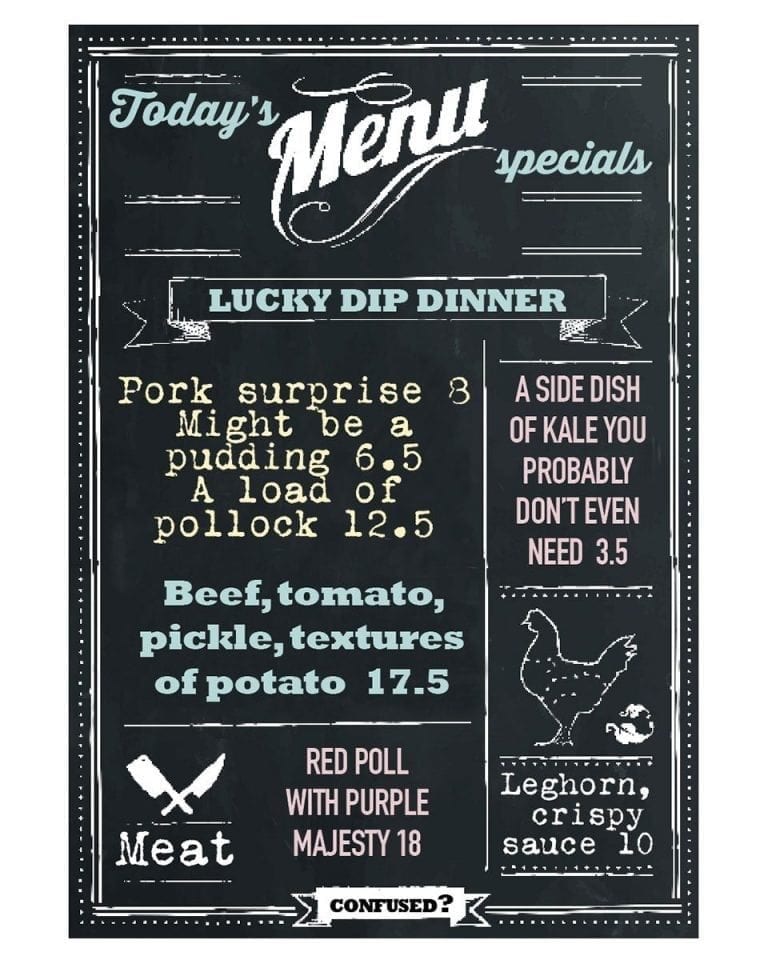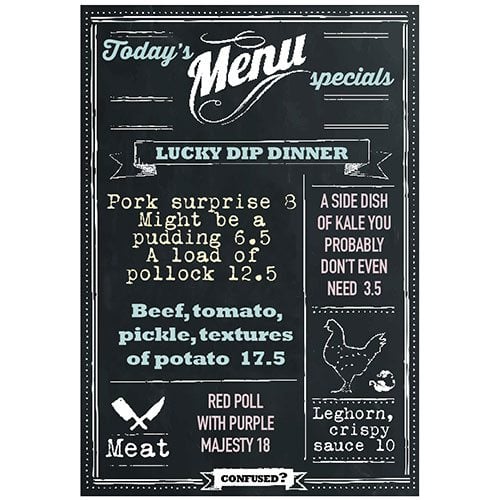The rant: Why are so many menus written in code?
Deciding what to order when you’re out for a meal shouldn’t require a degree in semiotics or the interrogation skills of a special forces agent.
Why can’t a menu just describe the food?
Ella Tarn investigates…

If I learned anything from Horsegate 2013, it’s that I really don’t like the wool being pulled over my eyes when it comes to food. I want to know exactly what I’m eating. So why is the task of decoding contemporary restaurant menus akin to a stint at Bletchley Park? Some have become so opaque, they’re not even menus any more – more like word association games.
My biggest bugbear is menus that are essentially a list of ingredients, without a clue as to how they may have been prepared and how they’re served. I realise budgets are tight and every penny counts when running a restaurant, but surely it wouldn’t break the bank to pepper the menu with a few adjectives here and there, to help diners understand what the dish actually is?
I recently saw a menu that offered as a main course ‘Beef, tomato, pickle, textures of potato’. You’d be forgiven for thinking it would turn out to be an elaborately cooked beef dish – but no, it was a burger and chips. When did it become necessary for diners to play a game of 20 Questions with the waiter, just to find out what might end up on their dinner plate? Chefs, take note: a terse list of ingredients does not a menu make.
Another approach I’ve come across is to provide the customer with an uninterrupted list of dishes, without those boring, passé subheadings: starters, mains, side dishes and puddings. Radical, huh? To its credit, the menu I’m recalling did include some adjectives, but there was no discernible order to it. The jumble of prices (vogueishly pound-sign free and accurate to one decimal place, of course) gave no indication of the size of each dish. I had no idea
what to request – or in what order.
Had I missed something? Should I have known which were the smaller plates? Concerned I’d be judged for asking too many questions, I ordered what I thought would make a decent dinner – and ended up with a starter of bangers and mash (bewilderingly described as ‘pork, whisked potatoes’), followed by a light salad. Let’s just say there was no question of my dining partner having plate envy.
Adding to the diner’s general confusion are the Machiavellian tactics restaurants often use to skew our judgement, such as crowding all the cheaper dishes together and giving the more expensive options extra space.A properly designed restaurant menu should do two things well. It needs to have the kind of dishes on it that attract the customer in the first place, and it needs to present them in a way that’s tempting – and accurate. It doesn’t have to describe every single element in the dish (it’s often nice to have some surprises) but you need to know roughly what you’re getting.
When I go out for a meal, it’s for pleasure – I don’t want to be made to feel intellectually inferior for not understanding the menu. We may have moved on from the days of menus being written in French to intimidate us, but that’s been replaced by something just as bad: the new intimidation caused by wilful culinary obscurantism. I don’t want to be tricked into ordering something I didn’t want. And I certainly don’t want to have to interrogate the waiter before placing my order. My wish is a simple one: to understand what’s on offer, to be served what I expect and to enjoy the food before me. Surely simplicity isn’t too much to ask for? The current trend isn’t big or clever. It just upsets customers – and we are, after all, the ones footing the bill.
Do you agree with Ella or do you take a different view? Let us know in the comment section below.
Subscribe to our magazine
Food stories, skills and tested recipes, straight to your door... Enjoy 5 issues for just £5 with our special introductory offer.
Subscribe
Unleash your inner chef
Looking for inspiration? Receive the latest recipes with our newsletter


